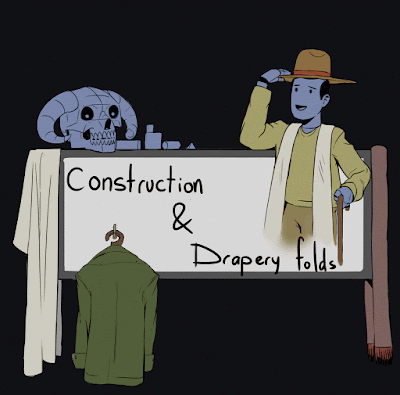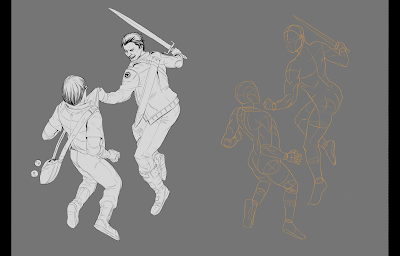Friday, December 25, 2015
Saturday, December 19, 2015
Changes and stuff
I've over come my hay fever
with out pharmaceutical :)
Done some small changes to this blog
was getting tired of the old look of the blog.
I might do some more changes if i have time>
( this is what the blog use to look like ^)Wednesday, December 2, 2015
Muscle name!!!!!
Got a new phone, with a better camera. Now it
will be much easier to post up drawings from my sketchbook
to this blog.
Here's a sketch I did last night for the Orbicularis oris muscle
Saturday, November 28, 2015
Friday, November 20, 2015
Form 6
--------------------------------------------------------------------------------------------------------------------
Learning to apply construction can be tedious and boring at times but its crucial to learn
and it especially helps with your imagination work, so you'll have to keep at it.
It is hard at the start but if you keep at it, it will pay off.
To make the construction phase more interesting I've decided
to learn about different types of folds too.
For each type of fold, I did these things in the first image (the gif):
(1) started with a rough sketch for the pose for the character
(1) started with a rough sketch for the pose for the character
(2) then I lowered the opacity of the rough sketch layer and made a new layer
to draw the clean basic construction.
(3) then made another layer and drew clothes, folds and hair etc.
(4) made another new layer for the final black clean lines
Never give up and keep at it!
Like I said before construction can be tedious at times
but once you get used to it, you'll start to have a lot of fun figuring
out how things connect together.
Construction is the type of thing that you can't just read and expect to be able to do it.
You have to put a lot of hours into understanding this and drilling it into your brain.
I bought some new sketchbooks and double-headed coloured pencils
for the underlying construction and some great black ink pens for the
clean over drawing.
After compiling years of drawing with a logical construction
process then it will come second nature.
Then if you want to make the move to freehand drawing
it's very hard at first but just keep at it.
The next exercise is just like the last exercise in form number 5 >
first you draw the construction but instead of drawing over it
you draw the image that you wanted beside it.
Tuesday, November 17, 2015
two muscle names!!
Levator labii superioris
----------------------------------------------------------------------------------------------------------------------
Levator labii superioris alaeque nasi
Sunday, October 18, 2015
Saturday, October 10, 2015
Keep drawing or I'll run you over
Two artist I know Kod & James just started a blog/FB art page
so give them a FB like or a blog follow so say Hi :)
Friday, October 9, 2015
Tuesday, October 6, 2015
Form 05
These planes will not be dealing with light sources - I will get into that later.
This post will help with getting to know irregular things like convex and concave
surfaces, and relative proportions.
------------------------------------------------------------------------------------------------
Here's some helpful basic exercises to get your brain used to
drawing on the illusion of a plane.
(A) Draw some relatively basic block objects, then use a red pen to
draw straight lines across their planes. Try to get the feel of the planes.
(B) Draw some basic objects and boxes. Then draw/graffiti on them.
Try to imagine that you're drawing on a surface in that plane's perspective.
(C) Again draw some basic objects then try to draw other objects
coating the surfaces like rocks, leaves, hair and any other
objects you can think of.
I found it helpful to draw a range of planes on three heads,
each had a different number of planes, low to high:
(1) simple (2) moderate (3) complex
Then I did a study of the skull from my skeleton, referencing the range
of planes from the heads in the picture above.
I turned the object I was drawing (skull) into simple planes,
looking at the heads to remind me to draw the right amount of them.
This can help with learning how to break down round shapes into flat planes.
This exercise will help your planes and proportions of your
imagination work.
(A) construct a monster/person then draw the planes over the construction (red).
Then draw over it with black pen using the planes to guide your drawing.
Imagine you're drawing on a 3D low poly model
Then when you get good at that, try (B)
(B) this is like like (a) but you don't draw over it, instead you
draw your image beside it and use the drawing with planes as reference.
If you found that easy, try putting the constructed plane image away
and try it from memory. Good luck!
Saturday, September 26, 2015
Saturday, September 19, 2015
Two Muscle names
After learning the names of the human bones.
Now I what to learn the names of the muscles.
So here a random sketch thing to go with the names
frontalis muscle & temporalis muscle
Friday, September 18, 2015
Form 04
Understanding form from Life, Photo, Memory & Imagination
Here are some exercises to help to understand
the object's form and get an idea out out of your brain easier.
I think this is very crucial if you want to be a concept artist.
(These exercises can be hard so start with simple objects
then work your way up to harder stuff )
1. From life
First I found some interesting objects in the house and kitchen and I stared at each one to see the block shapes. Once I understood what block shapes it was made up of, I drew the object's construction out with a colouring pencil on a different angle. I then went over the construction with a black ink pen. (The scanner didn't pick up the colouring pencil that well :/ )
2. From photo
This is like no.1 (From life) above but it's from a flat image.
Drawing from a photo and drawing from life are not the same.
So this time we are going to try to put the flat information back into 3D information
in our brains, then draw them on a different angle just like no.1 (from life).
3. Short & long term memory
This a really good exercise but really hard too.
So for the short term memory, I walked around the house finding
some objects then I looked at them carefully to work out their construction.
I quickly went back to my office (at home) to draw them
but with a different angle than when I looked at them.
For the long term memory, I tried to remember some things from years ago.
I thought this would be easy but it was really hard.
I did the same thing with the block shapes and then drawing it.
4. Imagination
This is the same exercise as the others but the first step to this one is
to imagine anything you want :)
Monday, August 31, 2015
Form 03
Training your brain to do more
3-Dimensional drawings
Get your brain warmed up to drawing more 3-Dimensional
shapes to get away from flat 2-Dimensional drawing.
Not to say drawing flat is bad it's just to help your brain to
distinguish from the two. I find it helpful to think like a 3D modeller
and imagine that you are drawing with blocks.
I did an A4 page after work for a week.
Drawing objects inside box
Another helpful trick is to
Draw objects inside boxes, this should help you see and
align the object's proportions better.
I found this really helpful :)
Friday, August 28, 2015
Subscribe to:
Posts (Atom)


















































